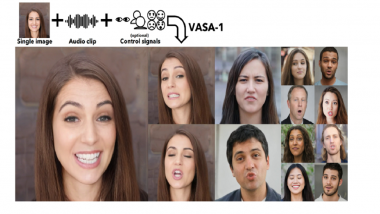New Delhi, April 20: Microsoft has introduced an advanced AI model, "VASA-1" capable of transforming still images into dynamic videos. The AI model also referred to as Visual Affective Skills Audio (VASA-1), offers a new aspect to digital content by generating realistic talking faces for virtual characters.
The VASA-1 AI model animates photos and gives options for fine-tuned control over video customisation. Such technology opens up a world of possibilities for creators needing virtual AI avatars or an Image-To-Video Tool and Microsoft's VASA-1 is at a leading edge of such technology. Microsoft Invests USD 1.5 Billion in UAE-Based Artificial Intelligence Technology Company G42.
As per a report of India Today, Microsoft announces the VASA-1 AI model, a tool that's designed to turn images into videos, but it's not yet available for public use. This development might have generated interest in the applications of such an AI model. The Microsoft VASA-1 AI model likely to revolutionise how people think about and interact with images, which offer a glimpse into the future of AI-generated media.
How Does Microsoft VASA-1 Work?
The VASA-1 AI model operates by analysing the details of a given image and animate facial movements that are related to speech and emotion. The resulting videos are not just static faces mouthing words; they are virtual characters that can interact in a more human-like manner. Microsoft VASA-1 allows users to adjust specific aspects of the generated video, providing a level of customisation. The control is granular, meaning every little detail can potentially be tweaked to achieve the desired outcome.
The VASA 1 model by Microsoft is designed to produce high-quality video content featuring realistic facial and head movements. It can generate 512 x 512 videos at 40fps with minimal latency and might create videos up to one minute in length. The latest AI model, “VASA 1” developed by Microsoft, showcases the ability to process images and audio inputs that fall outside the training data distribution. It offers control over appearance, 3D head pose and facial dynamics, which will likely enable users to enhance the output effectively. Meta Introduces Llama 3 AI Model: Company Launches First Two Models of Next Generation of Llama.
Microsoft might not release VASA-1 to the public for now, likely due to ethical considerations. The focus is expected on using this technology for positive purposes, such as enhancing virtual AI avatars and actively working to prevent misuse like impersonation through improved forgery detection methods.
(The above story first appeared on LatestLY on Apr 20, 2024 07:01 PM IST. For more news and updates on politics, world, sports, entertainment and lifestyle, log on to our website latestly.com).













 Quickly
Quickly












